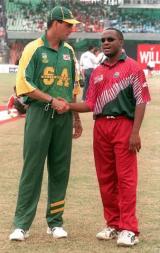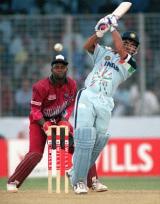When cricket really was the winner
|
|

|
Dhaka was only the third-choice venue for the competition, behind Disney World in Florida, and Sharjah; and it was nearly moved to Calcutta when Bangladesh was ravaged by one of its worst ever floods only weeks before the tournament. Yet it turned out to be the perfect site. Though the Bangladeshi team was not allowed to take part, the population reacted with enormous enthusiasm to the biggest sporting event -- some said the most positive event of any kind--in the country's short, fraught, history.
It was thus a tournament in which the winning really was less important than the taking part. South Africa won it by beating West Indies in the final, but not one journalist was there from either place. All nine Test-playing countries were obliged by ICC to send teams, which they did with varying degrees of enthusiasm. England, just starting an Ashes tour, won a special dispensation to send a Second Eleven on condition it looked like an England team and included only players with experience of one-day internationals. With so many players discarded by the selectors over the years, this was not a problem. Overcoming South Africa in blistering heat was.
|
|

|
Sachin Tendulkar seemed ubiquitous: on the field, he played the innings of the week, 141 against Australia, and purveyed his mixed-up offies and leggies with growing confidence; off the field, he seemed to be smiling winsomely in every TV advert. Jacques Kallis, who was man of the match in both the semi-final and final, and the brutal Barbadian Philo Wallace almost matched him as batsmen.
Hansie Cronje gained most in stature during the week, as both leader and player. When he held the trophy aloft, South Africa had firmly established themselves as long-range World Cup favourites. The real stars, though, were the population of Bangladesh. In villages without electricity, people huddled round radios listening to commentary, and kids began playing, Sri Lanka-style, with makeshift kit wherever there was a space. The moment Bangladesh gets a national team which does them credit, it will be cricket's boom country.
This article was published in the 2000 edition of the Wisden Almanack.
Match reports for
PQF: New Zealand v Zimbabwe at Dhaka, Oct 24, 1998
Report |
Scorecard
1st QF: England v South Africa at Dhaka, Oct 25, 1998
Report |
Scorecard
2nd QF: New Zealand v Sri Lanka at Dhaka, Oct 26, 1998
Report |
Scorecard
3rd QF: Australia v India at Dhaka, Oct 28, 1998
Report |
Scorecard
4th QF: Pakistan v West Indies at Dhaka, Oct 29, 1998
Report |
Scorecard
1st Semi-Final: South Africa v Sri Lanka at Dhaka, Oct 30, 1998
Report |
Scorecard
2nd Semi-Final: India v West Indies at Dhaka, Oct 31, 1998
Report |
Scorecard
Final: South Africa v West Indies at Dhaka, Nov 1, 1998
Report |
Scorecard

